Taxation Law Case Study: Individual Taxpayer - Semester 2, 2024
VerifiedAdded on 2022/08/28
|14
|3058
|11
Case Study
AI Summary
This case study analyzes the tax liability of an individual taxpayer, Eric, who has income from employment, business, and rental properties. It applies the provisions of ITAA 1997 and ITAA 1936 to determine assessable income, allowable deductions, and tax payable. The analysis covers employment income (including gross wages, shift allowances, and fringe benefits), business income (including cash receipts, trading stock, and compensation for loss of income), and rental property income (including rent received and related expenses). The study also considers relevant case law and provides calculations for various tax components, concluding with an assessment of the client's tax position and potential strategies. It addresses work-related expenses, depreciation, and the treatment of various income sources and deductions, providing a detailed understanding of the individual's tax obligations.
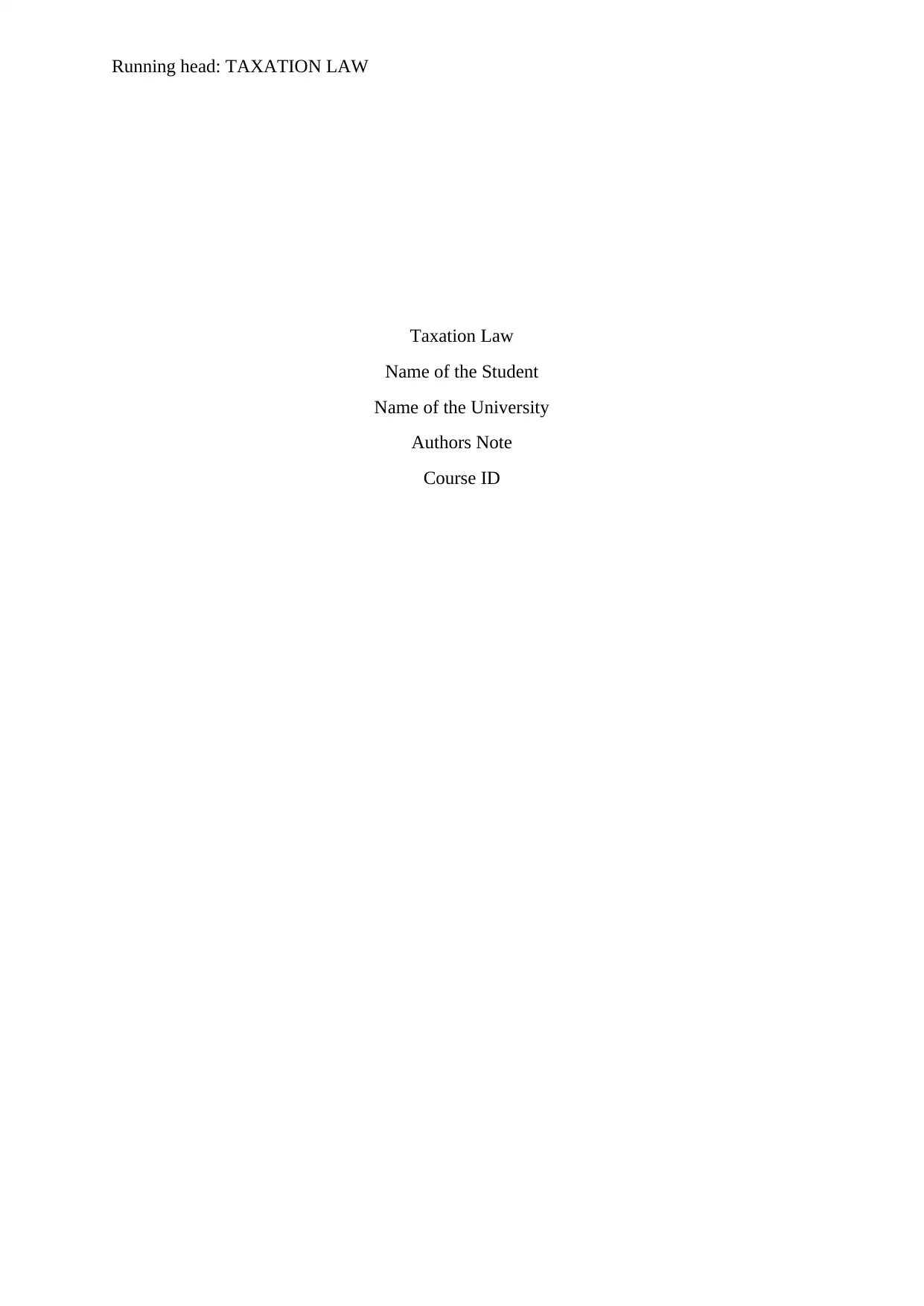
Running head: TAXATION LAW
Taxation Law
Name of the Student
Name of the University
Authors Note
Course ID
Taxation Law
Name of the Student
Name of the University
Authors Note
Course ID
Paraphrase This Document
Need a fresh take? Get an instant paraphrase of this document with our AI Paraphraser
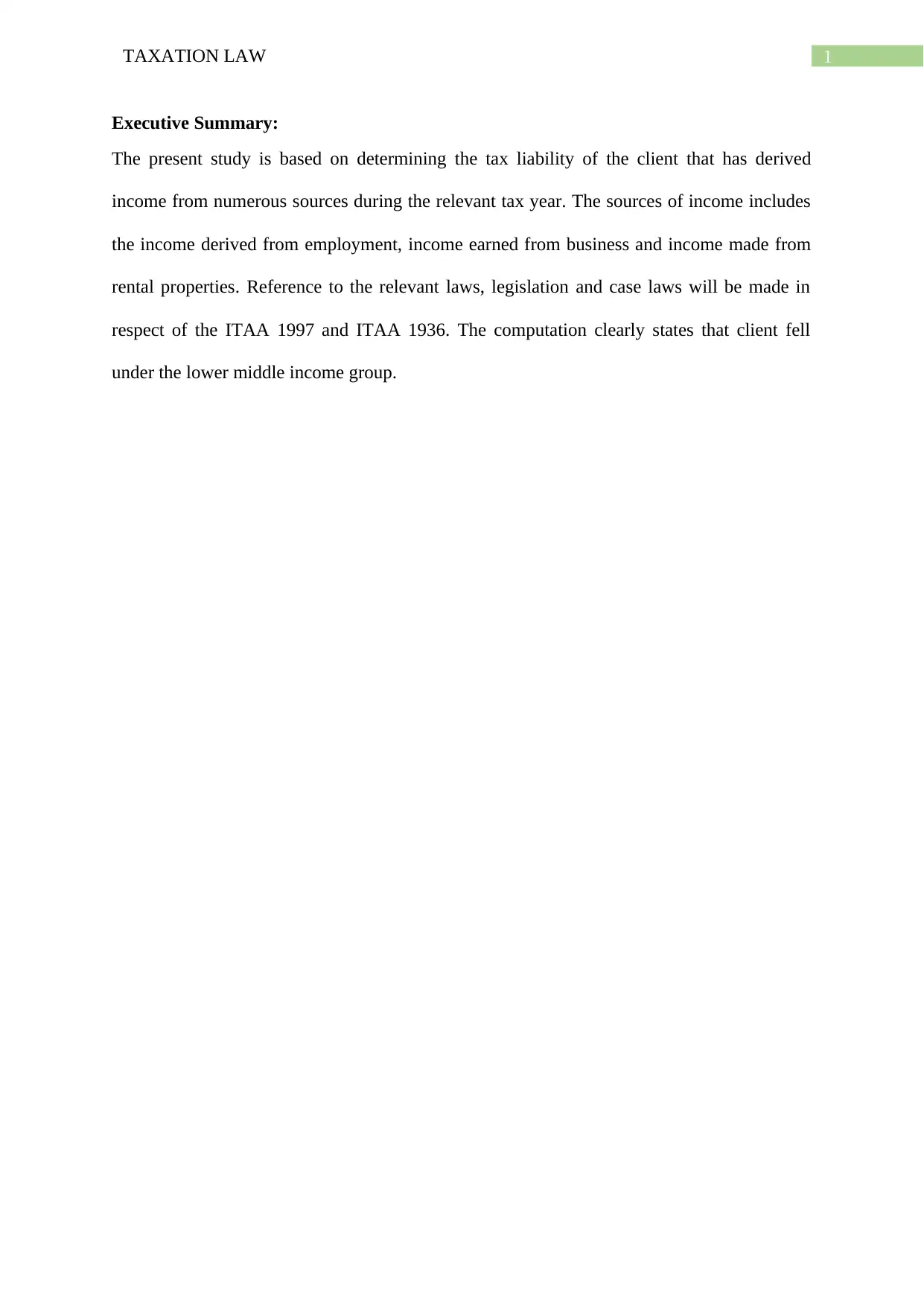
1TAXATION LAW
Executive Summary:
The present study is based on determining the tax liability of the client that has derived
income from numerous sources during the relevant tax year. The sources of income includes
the income derived from employment, income earned from business and income made from
rental properties. Reference to the relevant laws, legislation and case laws will be made in
respect of the ITAA 1997 and ITAA 1936. The computation clearly states that client fell
under the lower middle income group.
Executive Summary:
The present study is based on determining the tax liability of the client that has derived
income from numerous sources during the relevant tax year. The sources of income includes
the income derived from employment, income earned from business and income made from
rental properties. Reference to the relevant laws, legislation and case laws will be made in
respect of the ITAA 1997 and ITAA 1936. The computation clearly states that client fell
under the lower middle income group.
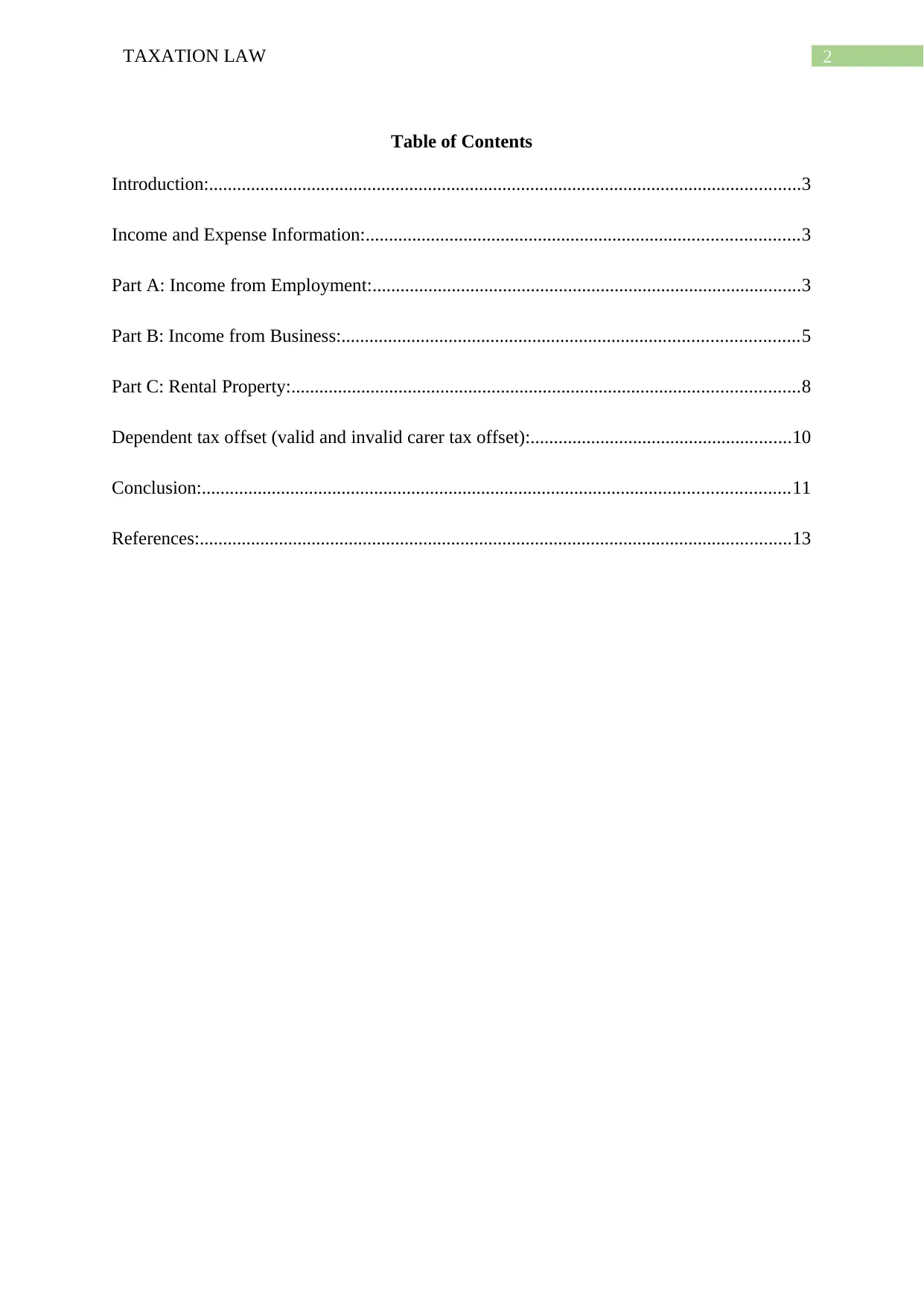
2TAXATION LAW
Table of Contents
Introduction:...............................................................................................................................3
Income and Expense Information:.............................................................................................3
Part A: Income from Employment:............................................................................................3
Part B: Income from Business:..................................................................................................5
Part C: Rental Property:.............................................................................................................8
Dependent tax offset (valid and invalid carer tax offset):........................................................10
Conclusion:..............................................................................................................................11
References:...............................................................................................................................13
Table of Contents
Introduction:...............................................................................................................................3
Income and Expense Information:.............................................................................................3
Part A: Income from Employment:............................................................................................3
Part B: Income from Business:..................................................................................................5
Part C: Rental Property:.............................................................................................................8
Dependent tax offset (valid and invalid carer tax offset):........................................................10
Conclusion:..............................................................................................................................11
References:...............................................................................................................................13
⊘ This is a preview!⊘
Do you want full access?
Subscribe today to unlock all pages.

Trusted by 1+ million students worldwide
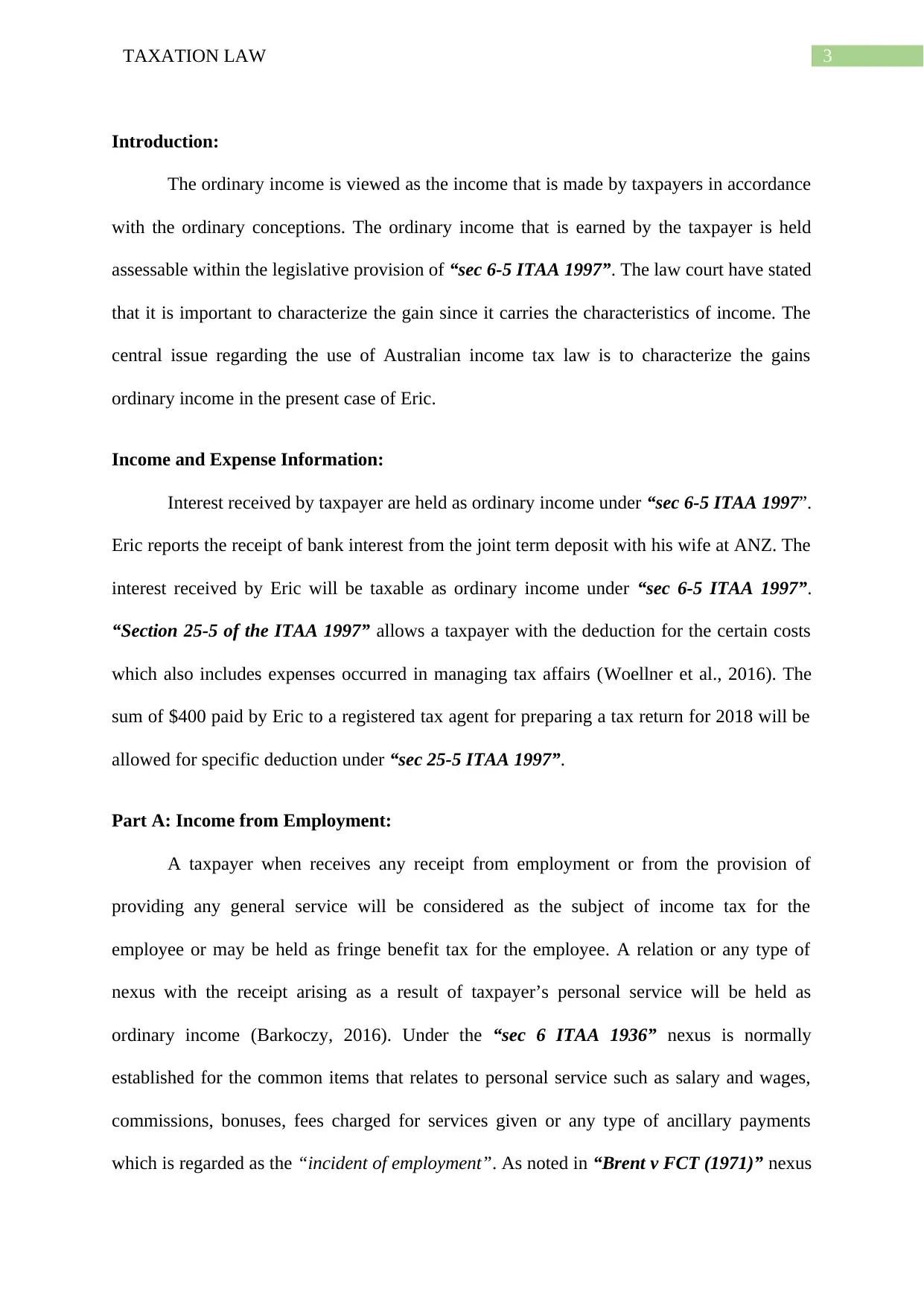
3TAXATION LAW
Introduction:
The ordinary income is viewed as the income that is made by taxpayers in accordance
with the ordinary conceptions. The ordinary income that is earned by the taxpayer is held
assessable within the legislative provision of “sec 6-5 ITAA 1997”. The law court have stated
that it is important to characterize the gain since it carries the characteristics of income. The
central issue regarding the use of Australian income tax law is to characterize the gains
ordinary income in the present case of Eric.
Income and Expense Information:
Interest received by taxpayer are held as ordinary income under “sec 6-5 ITAA 1997”.
Eric reports the receipt of bank interest from the joint term deposit with his wife at ANZ. The
interest received by Eric will be taxable as ordinary income under “sec 6-5 ITAA 1997”.
“Section 25-5 of the ITAA 1997” allows a taxpayer with the deduction for the certain costs
which also includes expenses occurred in managing tax affairs (Woellner et al., 2016). The
sum of $400 paid by Eric to a registered tax agent for preparing a tax return for 2018 will be
allowed for specific deduction under “sec 25-5 ITAA 1997”.
Part A: Income from Employment:
A taxpayer when receives any receipt from employment or from the provision of
providing any general service will be considered as the subject of income tax for the
employee or may be held as fringe benefit tax for the employee. A relation or any type of
nexus with the receipt arising as a result of taxpayer’s personal service will be held as
ordinary income (Barkoczy, 2016). Under the “sec 6 ITAA 1936” nexus is normally
established for the common items that relates to personal service such as salary and wages,
commissions, bonuses, fees charged for services given or any type of ancillary payments
which is regarded as the “incident of employment”. As noted in “Brent v FCT (1971)” nexus
Introduction:
The ordinary income is viewed as the income that is made by taxpayers in accordance
with the ordinary conceptions. The ordinary income that is earned by the taxpayer is held
assessable within the legislative provision of “sec 6-5 ITAA 1997”. The law court have stated
that it is important to characterize the gain since it carries the characteristics of income. The
central issue regarding the use of Australian income tax law is to characterize the gains
ordinary income in the present case of Eric.
Income and Expense Information:
Interest received by taxpayer are held as ordinary income under “sec 6-5 ITAA 1997”.
Eric reports the receipt of bank interest from the joint term deposit with his wife at ANZ. The
interest received by Eric will be taxable as ordinary income under “sec 6-5 ITAA 1997”.
“Section 25-5 of the ITAA 1997” allows a taxpayer with the deduction for the certain costs
which also includes expenses occurred in managing tax affairs (Woellner et al., 2016). The
sum of $400 paid by Eric to a registered tax agent for preparing a tax return for 2018 will be
allowed for specific deduction under “sec 25-5 ITAA 1997”.
Part A: Income from Employment:
A taxpayer when receives any receipt from employment or from the provision of
providing any general service will be considered as the subject of income tax for the
employee or may be held as fringe benefit tax for the employee. A relation or any type of
nexus with the receipt arising as a result of taxpayer’s personal service will be held as
ordinary income (Barkoczy, 2016). Under the “sec 6 ITAA 1936” nexus is normally
established for the common items that relates to personal service such as salary and wages,
commissions, bonuses, fees charged for services given or any type of ancillary payments
which is regarded as the “incident of employment”. As noted in “Brent v FCT (1971)” nexus
Paraphrase This Document
Need a fresh take? Get an instant paraphrase of this document with our AI Paraphraser
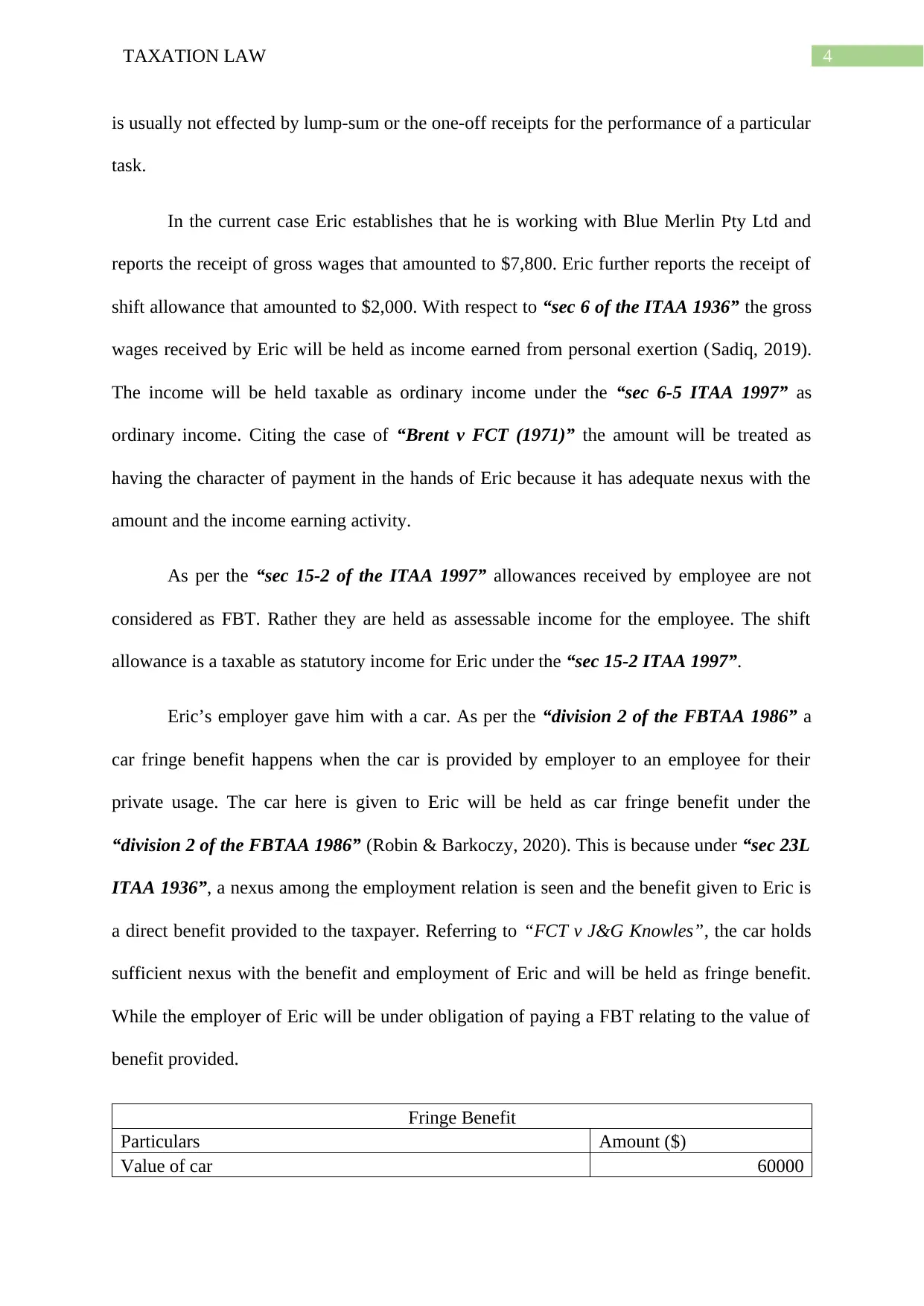
4TAXATION LAW
is usually not effected by lump-sum or the one-off receipts for the performance of a particular
task.
In the current case Eric establishes that he is working with Blue Merlin Pty Ltd and
reports the receipt of gross wages that amounted to $7,800. Eric further reports the receipt of
shift allowance that amounted to $2,000. With respect to “sec 6 of the ITAA 1936” the gross
wages received by Eric will be held as income earned from personal exertion (Sadiq, 2019).
The income will be held taxable as ordinary income under the “sec 6-5 ITAA 1997” as
ordinary income. Citing the case of “Brent v FCT (1971)” the amount will be treated as
having the character of payment in the hands of Eric because it has adequate nexus with the
amount and the income earning activity.
As per the “sec 15-2 of the ITAA 1997” allowances received by employee are not
considered as FBT. Rather they are held as assessable income for the employee. The shift
allowance is a taxable as statutory income for Eric under the “sec 15-2 ITAA 1997”.
Eric’s employer gave him with a car. As per the “division 2 of the FBTAA 1986” a
car fringe benefit happens when the car is provided by employer to an employee for their
private usage. The car here is given to Eric will be held as car fringe benefit under the
“division 2 of the FBTAA 1986” (Robin & Barkoczy, 2020). This is because under “sec 23L
ITAA 1936”, a nexus among the employment relation is seen and the benefit given to Eric is
a direct benefit provided to the taxpayer. Referring to “FCT v J&G Knowles”, the car holds
sufficient nexus with the benefit and employment of Eric and will be held as fringe benefit.
While the employer of Eric will be under obligation of paying a FBT relating to the value of
benefit provided.
Fringe Benefit
Particulars Amount ($)
Value of car 60000
is usually not effected by lump-sum or the one-off receipts for the performance of a particular
task.
In the current case Eric establishes that he is working with Blue Merlin Pty Ltd and
reports the receipt of gross wages that amounted to $7,800. Eric further reports the receipt of
shift allowance that amounted to $2,000. With respect to “sec 6 of the ITAA 1936” the gross
wages received by Eric will be held as income earned from personal exertion (Sadiq, 2019).
The income will be held taxable as ordinary income under the “sec 6-5 ITAA 1997” as
ordinary income. Citing the case of “Brent v FCT (1971)” the amount will be treated as
having the character of payment in the hands of Eric because it has adequate nexus with the
amount and the income earning activity.
As per the “sec 15-2 of the ITAA 1997” allowances received by employee are not
considered as FBT. Rather they are held as assessable income for the employee. The shift
allowance is a taxable as statutory income for Eric under the “sec 15-2 ITAA 1997”.
Eric’s employer gave him with a car. As per the “division 2 of the FBTAA 1986” a
car fringe benefit happens when the car is provided by employer to an employee for their
private usage. The car here is given to Eric will be held as car fringe benefit under the
“division 2 of the FBTAA 1986” (Robin & Barkoczy, 2020). This is because under “sec 23L
ITAA 1936”, a nexus among the employment relation is seen and the benefit given to Eric is
a direct benefit provided to the taxpayer. Referring to “FCT v J&G Knowles”, the car holds
sufficient nexus with the benefit and employment of Eric and will be held as fringe benefit.
While the employer of Eric will be under obligation of paying a FBT relating to the value of
benefit provided.
Fringe Benefit
Particulars Amount ($)
Value of car 60000
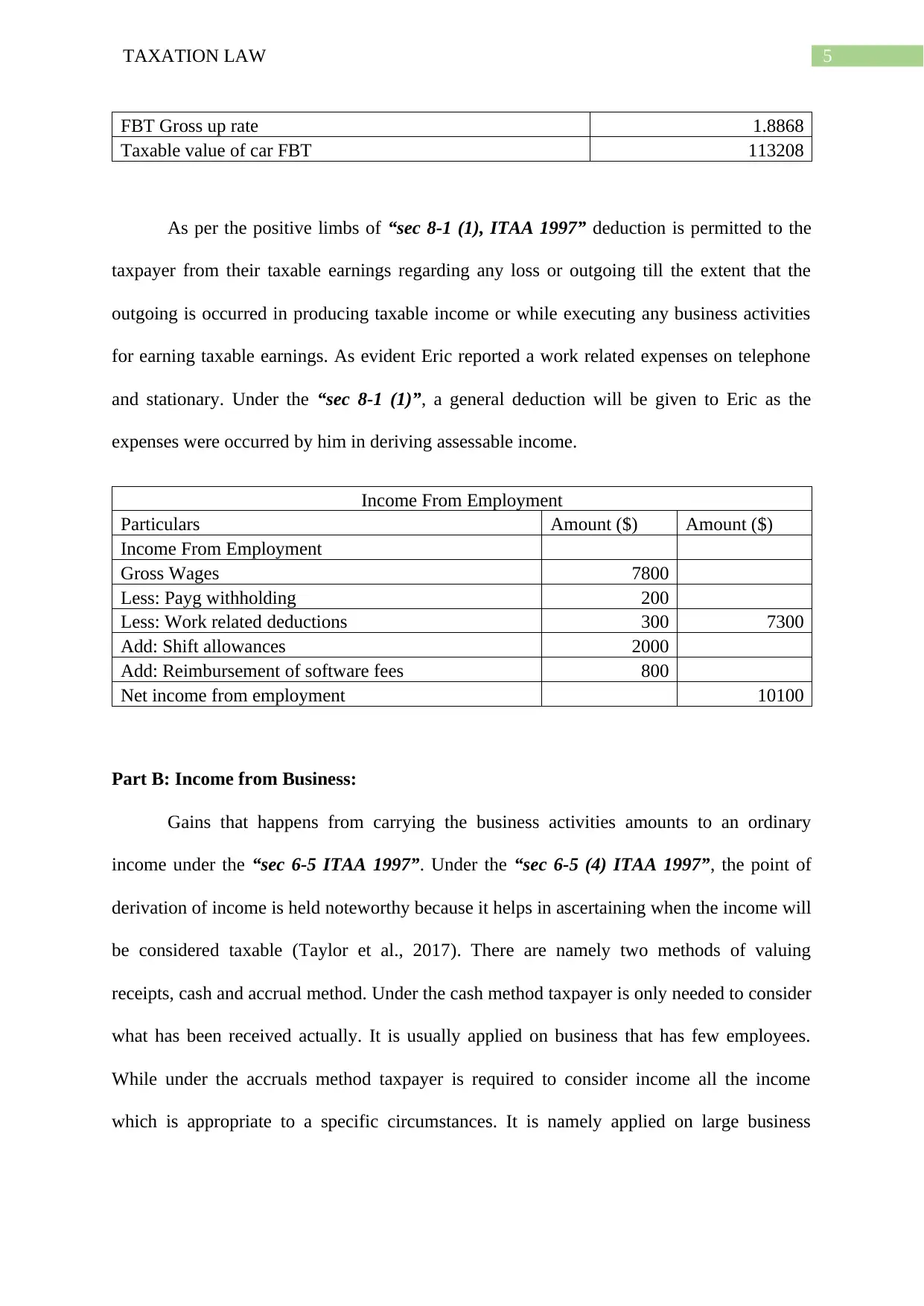
5TAXATION LAW
FBT Gross up rate 1.8868
Taxable value of car FBT 113208
As per the positive limbs of “sec 8-1 (1), ITAA 1997” deduction is permitted to the
taxpayer from their taxable earnings regarding any loss or outgoing till the extent that the
outgoing is occurred in producing taxable income or while executing any business activities
for earning taxable earnings. As evident Eric reported a work related expenses on telephone
and stationary. Under the “sec 8-1 (1)”, a general deduction will be given to Eric as the
expenses were occurred by him in deriving assessable income.
Income From Employment
Particulars Amount ($) Amount ($)
Income From Employment
Gross Wages 7800
Less: Payg withholding 200
Less: Work related deductions 300 7300
Add: Shift allowances 2000
Add: Reimbursement of software fees 800
Net income from employment 10100
Part B: Income from Business:
Gains that happens from carrying the business activities amounts to an ordinary
income under the “sec 6-5 ITAA 1997”. Under the “sec 6-5 (4) ITAA 1997”, the point of
derivation of income is held noteworthy because it helps in ascertaining when the income will
be considered taxable (Taylor et al., 2017). There are namely two methods of valuing
receipts, cash and accrual method. Under the cash method taxpayer is only needed to consider
what has been received actually. It is usually applied on business that has few employees.
While under the accruals method taxpayer is required to consider income all the income
which is appropriate to a specific circumstances. It is namely applied on large business
FBT Gross up rate 1.8868
Taxable value of car FBT 113208
As per the positive limbs of “sec 8-1 (1), ITAA 1997” deduction is permitted to the
taxpayer from their taxable earnings regarding any loss or outgoing till the extent that the
outgoing is occurred in producing taxable income or while executing any business activities
for earning taxable earnings. As evident Eric reported a work related expenses on telephone
and stationary. Under the “sec 8-1 (1)”, a general deduction will be given to Eric as the
expenses were occurred by him in deriving assessable income.
Income From Employment
Particulars Amount ($) Amount ($)
Income From Employment
Gross Wages 7800
Less: Payg withholding 200
Less: Work related deductions 300 7300
Add: Shift allowances 2000
Add: Reimbursement of software fees 800
Net income from employment 10100
Part B: Income from Business:
Gains that happens from carrying the business activities amounts to an ordinary
income under the “sec 6-5 ITAA 1997”. Under the “sec 6-5 (4) ITAA 1997”, the point of
derivation of income is held noteworthy because it helps in ascertaining when the income will
be considered taxable (Taylor et al., 2017). There are namely two methods of valuing
receipts, cash and accrual method. Under the cash method taxpayer is only needed to consider
what has been received actually. It is usually applied on business that has few employees.
While under the accruals method taxpayer is required to consider income all the income
which is appropriate to a specific circumstances. It is namely applied on large business
⊘ This is a preview!⊘
Do you want full access?
Subscribe today to unlock all pages.

Trusted by 1+ million students worldwide
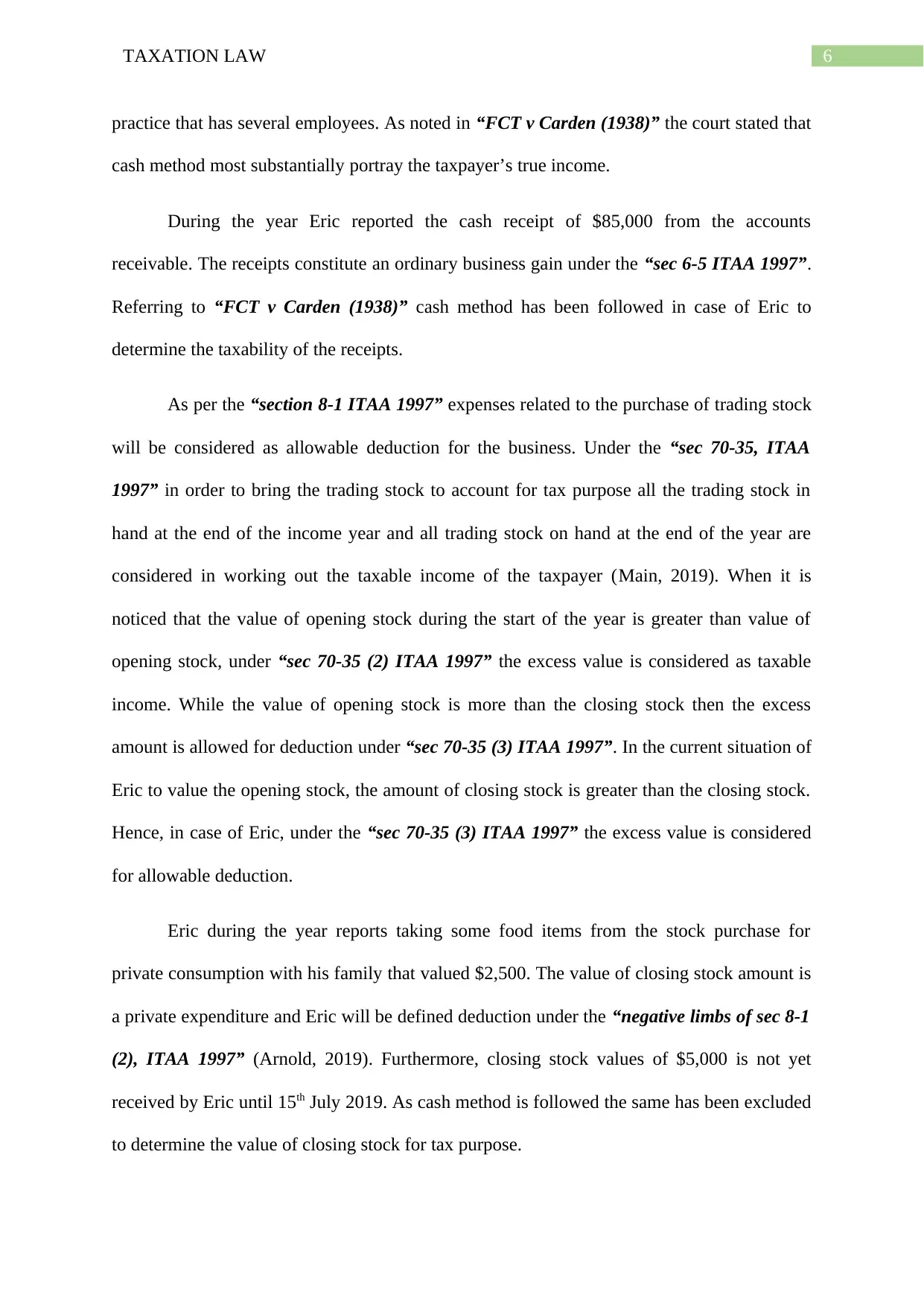
6TAXATION LAW
practice that has several employees. As noted in “FCT v Carden (1938)” the court stated that
cash method most substantially portray the taxpayer’s true income.
During the year Eric reported the cash receipt of $85,000 from the accounts
receivable. The receipts constitute an ordinary business gain under the “sec 6-5 ITAA 1997”.
Referring to “FCT v Carden (1938)” cash method has been followed in case of Eric to
determine the taxability of the receipts.
As per the “section 8-1 ITAA 1997” expenses related to the purchase of trading stock
will be considered as allowable deduction for the business. Under the “sec 70-35, ITAA
1997” in order to bring the trading stock to account for tax purpose all the trading stock in
hand at the end of the income year and all trading stock on hand at the end of the year are
considered in working out the taxable income of the taxpayer (Main, 2019). When it is
noticed that the value of opening stock during the start of the year is greater than value of
opening stock, under “sec 70-35 (2) ITAA 1997” the excess value is considered as taxable
income. While the value of opening stock is more than the closing stock then the excess
amount is allowed for deduction under “sec 70-35 (3) ITAA 1997”. In the current situation of
Eric to value the opening stock, the amount of closing stock is greater than the closing stock.
Hence, in case of Eric, under the “sec 70-35 (3) ITAA 1997” the excess value is considered
for allowable deduction.
Eric during the year reports taking some food items from the stock purchase for
private consumption with his family that valued $2,500. The value of closing stock amount is
a private expenditure and Eric will be defined deduction under the “negative limbs of sec 8-1
(2), ITAA 1997” (Arnold, 2019). Furthermore, closing stock values of $5,000 is not yet
received by Eric until 15th July 2019. As cash method is followed the same has been excluded
to determine the value of closing stock for tax purpose.
practice that has several employees. As noted in “FCT v Carden (1938)” the court stated that
cash method most substantially portray the taxpayer’s true income.
During the year Eric reported the cash receipt of $85,000 from the accounts
receivable. The receipts constitute an ordinary business gain under the “sec 6-5 ITAA 1997”.
Referring to “FCT v Carden (1938)” cash method has been followed in case of Eric to
determine the taxability of the receipts.
As per the “section 8-1 ITAA 1997” expenses related to the purchase of trading stock
will be considered as allowable deduction for the business. Under the “sec 70-35, ITAA
1997” in order to bring the trading stock to account for tax purpose all the trading stock in
hand at the end of the income year and all trading stock on hand at the end of the year are
considered in working out the taxable income of the taxpayer (Main, 2019). When it is
noticed that the value of opening stock during the start of the year is greater than value of
opening stock, under “sec 70-35 (2) ITAA 1997” the excess value is considered as taxable
income. While the value of opening stock is more than the closing stock then the excess
amount is allowed for deduction under “sec 70-35 (3) ITAA 1997”. In the current situation of
Eric to value the opening stock, the amount of closing stock is greater than the closing stock.
Hence, in case of Eric, under the “sec 70-35 (3) ITAA 1997” the excess value is considered
for allowable deduction.
Eric during the year reports taking some food items from the stock purchase for
private consumption with his family that valued $2,500. The value of closing stock amount is
a private expenditure and Eric will be defined deduction under the “negative limbs of sec 8-1
(2), ITAA 1997” (Arnold, 2019). Furthermore, closing stock values of $5,000 is not yet
received by Eric until 15th July 2019. As cash method is followed the same has been excluded
to determine the value of closing stock for tax purpose.
Paraphrase This Document
Need a fresh take? Get an instant paraphrase of this document with our AI Paraphraser
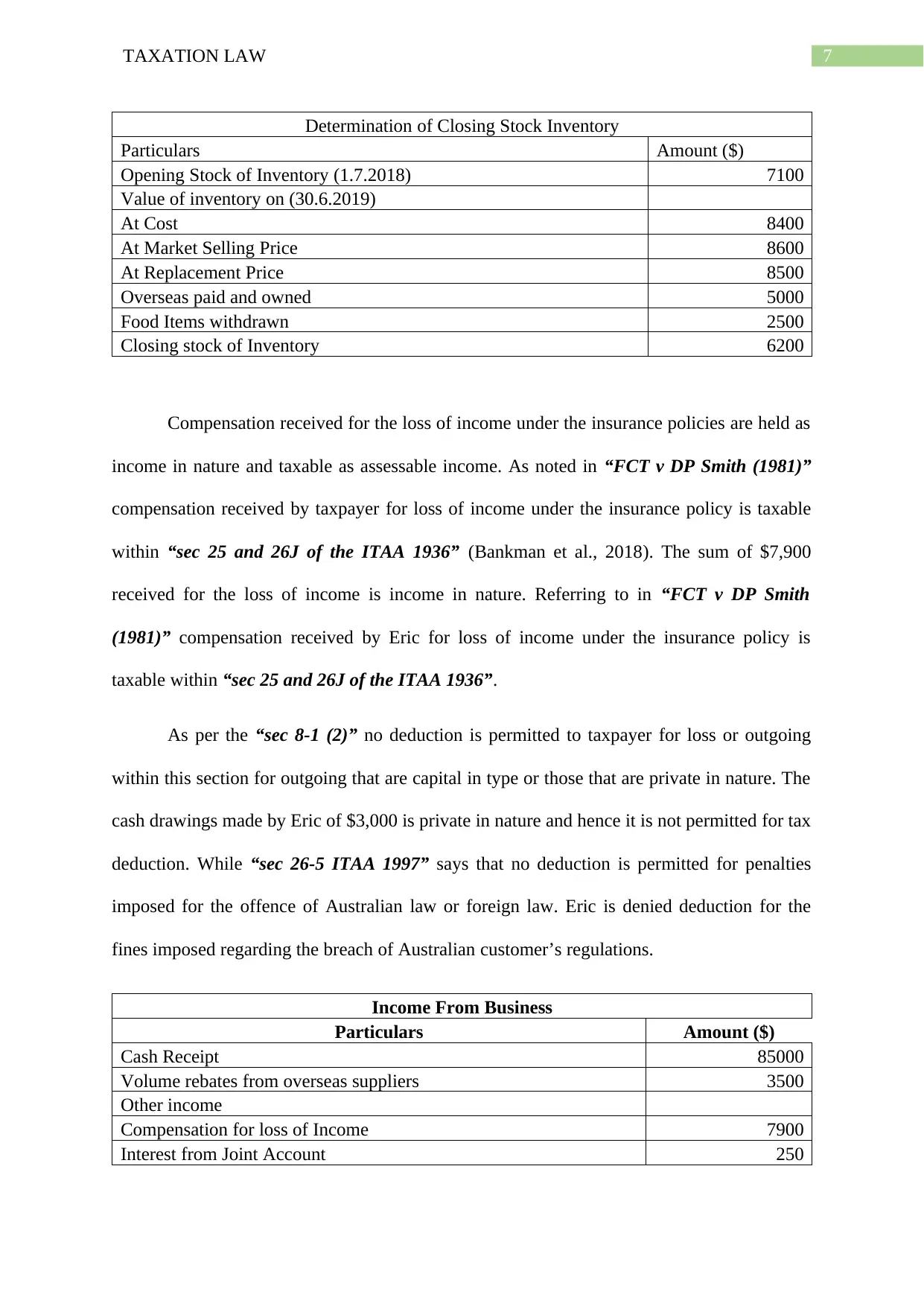
7TAXATION LAW
Determination of Closing Stock Inventory
Particulars Amount ($)
Opening Stock of Inventory (1.7.2018) 7100
Value of inventory on (30.6.2019)
At Cost 8400
At Market Selling Price 8600
At Replacement Price 8500
Overseas paid and owned 5000
Food Items withdrawn 2500
Closing stock of Inventory 6200
Compensation received for the loss of income under the insurance policies are held as
income in nature and taxable as assessable income. As noted in “FCT v DP Smith (1981)”
compensation received by taxpayer for loss of income under the insurance policy is taxable
within “sec 25 and 26J of the ITAA 1936” (Bankman et al., 2018). The sum of $7,900
received for the loss of income is income in nature. Referring to in “FCT v DP Smith
(1981)” compensation received by Eric for loss of income under the insurance policy is
taxable within “sec 25 and 26J of the ITAA 1936”.
As per the “sec 8-1 (2)” no deduction is permitted to taxpayer for loss or outgoing
within this section for outgoing that are capital in type or those that are private in nature. The
cash drawings made by Eric of $3,000 is private in nature and hence it is not permitted for tax
deduction. While “sec 26-5 ITAA 1997” says that no deduction is permitted for penalties
imposed for the offence of Australian law or foreign law. Eric is denied deduction for the
fines imposed regarding the breach of Australian customer’s regulations.
Income From Business
Particulars Amount ($)
Cash Receipt 85000
Volume rebates from overseas suppliers 3500
Other income
Compensation for loss of Income 7900
Interest from Joint Account 250
Determination of Closing Stock Inventory
Particulars Amount ($)
Opening Stock of Inventory (1.7.2018) 7100
Value of inventory on (30.6.2019)
At Cost 8400
At Market Selling Price 8600
At Replacement Price 8500
Overseas paid and owned 5000
Food Items withdrawn 2500
Closing stock of Inventory 6200
Compensation received for the loss of income under the insurance policies are held as
income in nature and taxable as assessable income. As noted in “FCT v DP Smith (1981)”
compensation received by taxpayer for loss of income under the insurance policy is taxable
within “sec 25 and 26J of the ITAA 1936” (Bankman et al., 2018). The sum of $7,900
received for the loss of income is income in nature. Referring to in “FCT v DP Smith
(1981)” compensation received by Eric for loss of income under the insurance policy is
taxable within “sec 25 and 26J of the ITAA 1936”.
As per the “sec 8-1 (2)” no deduction is permitted to taxpayer for loss or outgoing
within this section for outgoing that are capital in type or those that are private in nature. The
cash drawings made by Eric of $3,000 is private in nature and hence it is not permitted for tax
deduction. While “sec 26-5 ITAA 1997” says that no deduction is permitted for penalties
imposed for the offence of Australian law or foreign law. Eric is denied deduction for the
fines imposed regarding the breach of Australian customer’s regulations.
Income From Business
Particulars Amount ($)
Cash Receipt 85000
Volume rebates from overseas suppliers 3500
Other income
Compensation for loss of Income 7900
Interest from Joint Account 250
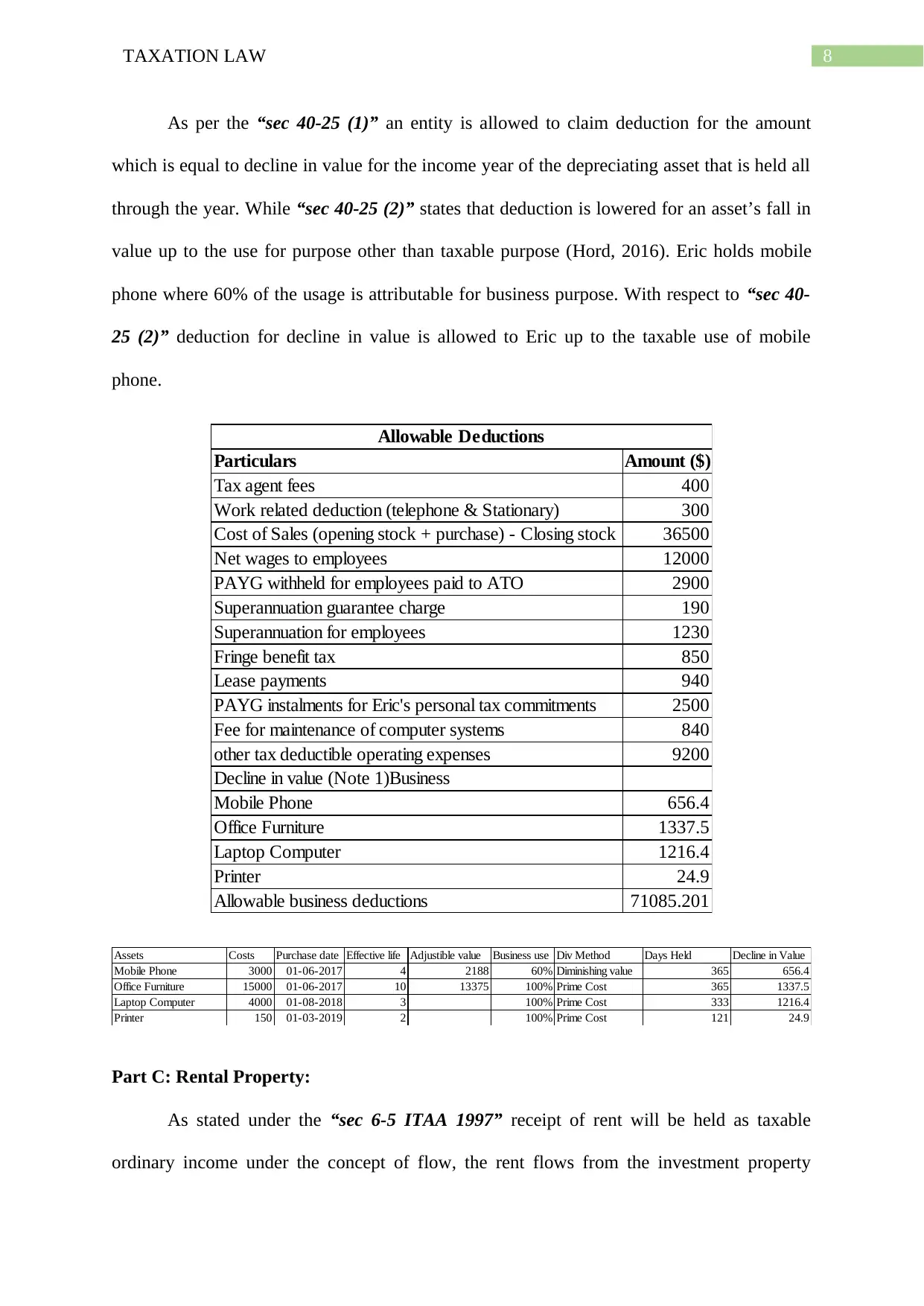
8TAXATION LAW
As per the “sec 40-25 (1)” an entity is allowed to claim deduction for the amount
which is equal to decline in value for the income year of the depreciating asset that is held all
through the year. While “sec 40-25 (2)” states that deduction is lowered for an asset’s fall in
value up to the use for purpose other than taxable purpose (Hord, 2016). Eric holds mobile
phone where 60% of the usage is attributable for business purpose. With respect to “sec 40-
25 (2)” deduction for decline in value is allowed to Eric up to the taxable use of mobile
phone.
Particulars Amount ($)
Tax agent fees 400
Work related deduction (telephone & Stationary) 300
Cost of Sales (opening stock + purchase) - Closing stock 36500
Net wages to employees 12000
PAYG withheld for employees paid to ATO 2900
Superannuation guarantee charge 190
Superannuation for employees 1230
Fringe benefit tax 850
Lease payments 940
PAYG instalments for Eric's personal tax commitments 2500
Fee for maintenance of computer systems 840
other tax deductible operating expenses 9200
Decline in value (Note 1)Business
Mobile Phone 656.4
Office Furniture 1337.5
Laptop Computer 1216.4
Printer 24.9
Allowable business deductions 71085.201
Allowable Deductions
Assets Costs Purchase date Effective life Adjustible value Business use Div Method Days Held Decline in Value
Mobile Phone 3000 01-06-2017 4 2188 60% Diminishing value 365 656.4
Office Furniture 15000 01-06-2017 10 13375 100% Prime Cost 365 1337.5
Laptop Computer 4000 01-08-2018 3 100% Prime Cost 333 1216.4
Printer 150 01-03-2019 2 100% Prime Cost 121 24.9
Part C: Rental Property:
As stated under the “sec 6-5 ITAA 1997” receipt of rent will be held as taxable
ordinary income under the concept of flow, the rent flows from the investment property
As per the “sec 40-25 (1)” an entity is allowed to claim deduction for the amount
which is equal to decline in value for the income year of the depreciating asset that is held all
through the year. While “sec 40-25 (2)” states that deduction is lowered for an asset’s fall in
value up to the use for purpose other than taxable purpose (Hord, 2016). Eric holds mobile
phone where 60% of the usage is attributable for business purpose. With respect to “sec 40-
25 (2)” deduction for decline in value is allowed to Eric up to the taxable use of mobile
phone.
Particulars Amount ($)
Tax agent fees 400
Work related deduction (telephone & Stationary) 300
Cost of Sales (opening stock + purchase) - Closing stock 36500
Net wages to employees 12000
PAYG withheld for employees paid to ATO 2900
Superannuation guarantee charge 190
Superannuation for employees 1230
Fringe benefit tax 850
Lease payments 940
PAYG instalments for Eric's personal tax commitments 2500
Fee for maintenance of computer systems 840
other tax deductible operating expenses 9200
Decline in value (Note 1)Business
Mobile Phone 656.4
Office Furniture 1337.5
Laptop Computer 1216.4
Printer 24.9
Allowable business deductions 71085.201
Allowable Deductions
Assets Costs Purchase date Effective life Adjustible value Business use Div Method Days Held Decline in Value
Mobile Phone 3000 01-06-2017 4 2188 60% Diminishing value 365 656.4
Office Furniture 15000 01-06-2017 10 13375 100% Prime Cost 365 1337.5
Laptop Computer 4000 01-08-2018 3 100% Prime Cost 333 1216.4
Printer 150 01-03-2019 2 100% Prime Cost 121 24.9
Part C: Rental Property:
As stated under the “sec 6-5 ITAA 1997” receipt of rent will be held as taxable
ordinary income under the concept of flow, the rent flows from the investment property
⊘ This is a preview!⊘
Do you want full access?
Subscribe today to unlock all pages.

Trusted by 1+ million students worldwide
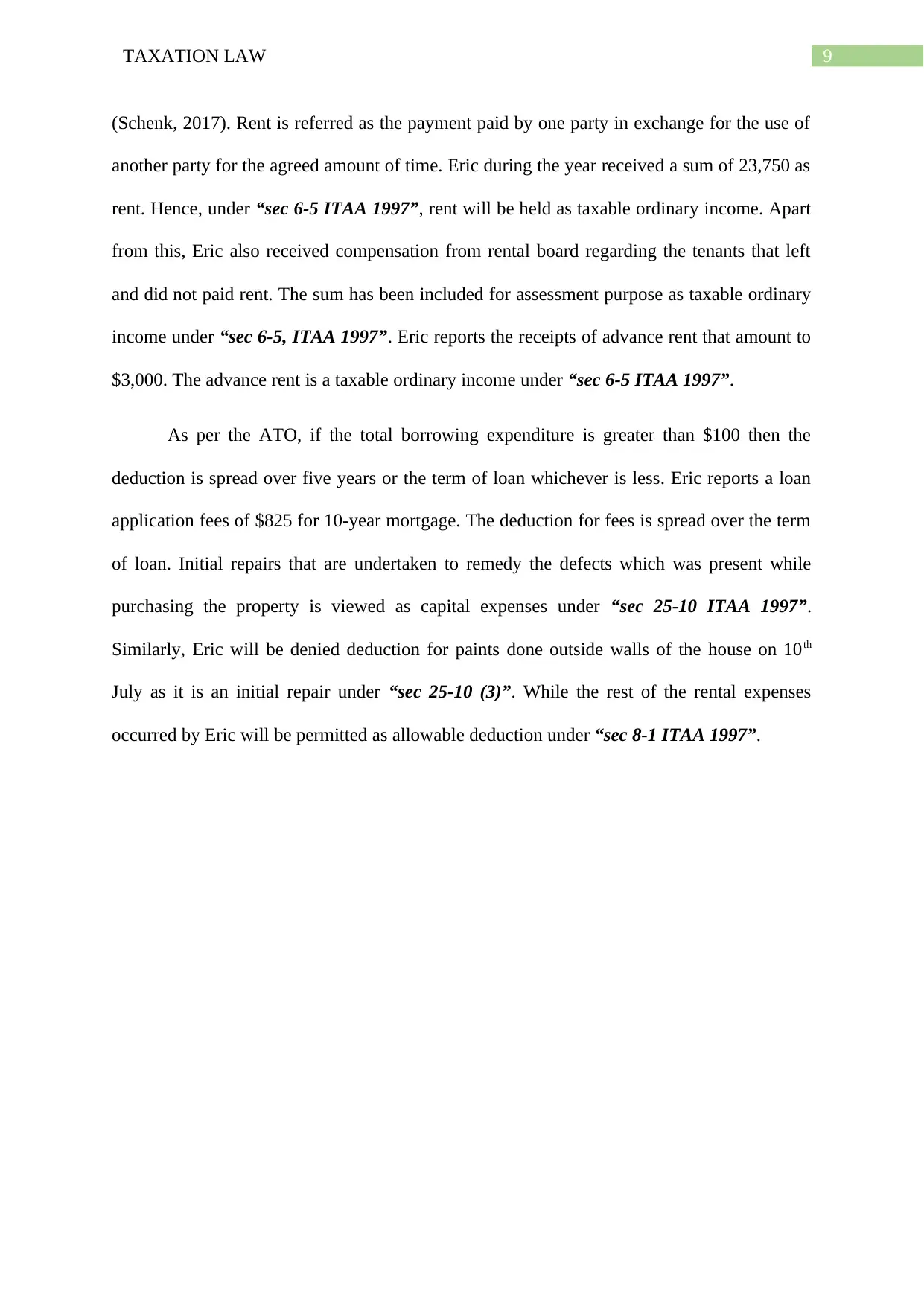
9TAXATION LAW
(Schenk, 2017). Rent is referred as the payment paid by one party in exchange for the use of
another party for the agreed amount of time. Eric during the year received a sum of 23,750 as
rent. Hence, under “sec 6-5 ITAA 1997”, rent will be held as taxable ordinary income. Apart
from this, Eric also received compensation from rental board regarding the tenants that left
and did not paid rent. The sum has been included for assessment purpose as taxable ordinary
income under “sec 6-5, ITAA 1997”. Eric reports the receipts of advance rent that amount to
$3,000. The advance rent is a taxable ordinary income under “sec 6-5 ITAA 1997”.
As per the ATO, if the total borrowing expenditure is greater than $100 then the
deduction is spread over five years or the term of loan whichever is less. Eric reports a loan
application fees of $825 for 10-year mortgage. The deduction for fees is spread over the term
of loan. Initial repairs that are undertaken to remedy the defects which was present while
purchasing the property is viewed as capital expenses under “sec 25-10 ITAA 1997”.
Similarly, Eric will be denied deduction for paints done outside walls of the house on 10th
July as it is an initial repair under “sec 25-10 (3)”. While the rest of the rental expenses
occurred by Eric will be permitted as allowable deduction under “sec 8-1 ITAA 1997”.
(Schenk, 2017). Rent is referred as the payment paid by one party in exchange for the use of
another party for the agreed amount of time. Eric during the year received a sum of 23,750 as
rent. Hence, under “sec 6-5 ITAA 1997”, rent will be held as taxable ordinary income. Apart
from this, Eric also received compensation from rental board regarding the tenants that left
and did not paid rent. The sum has been included for assessment purpose as taxable ordinary
income under “sec 6-5, ITAA 1997”. Eric reports the receipts of advance rent that amount to
$3,000. The advance rent is a taxable ordinary income under “sec 6-5 ITAA 1997”.
As per the ATO, if the total borrowing expenditure is greater than $100 then the
deduction is spread over five years or the term of loan whichever is less. Eric reports a loan
application fees of $825 for 10-year mortgage. The deduction for fees is spread over the term
of loan. Initial repairs that are undertaken to remedy the defects which was present while
purchasing the property is viewed as capital expenses under “sec 25-10 ITAA 1997”.
Similarly, Eric will be denied deduction for paints done outside walls of the house on 10th
July as it is an initial repair under “sec 25-10 (3)”. While the rest of the rental expenses
occurred by Eric will be permitted as allowable deduction under “sec 8-1 ITAA 1997”.
Paraphrase This Document
Need a fresh take? Get an instant paraphrase of this document with our AI Paraphraser
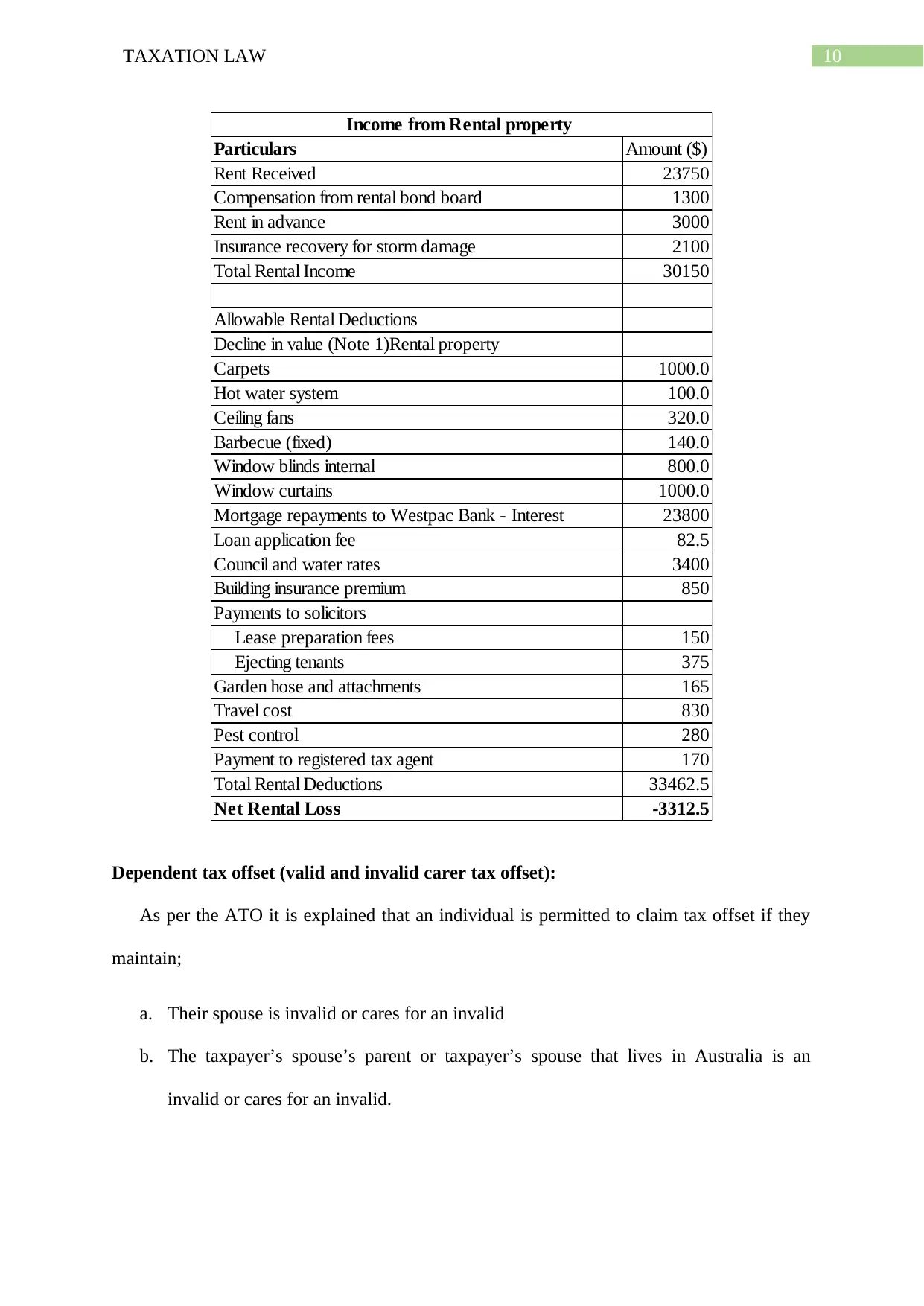
10TAXATION LAW
Particulars Amount ($)
Rent Received 23750
Compensation from rental bond board 1300
Rent in advance 3000
Insurance recovery for storm damage 2100
Total Rental Income 30150
Allowable Rental Deductions
Decline in value (Note 1)Rental property
Carpets 1000.0
Hot water system 100.0
Ceiling fans 320.0
Barbecue (fixed) 140.0
Window blinds internal 800.0
Window curtains 1000.0
Mortgage repayments to Westpac Bank - Interest 23800
Loan application fee 82.5
Council and water rates 3400
Building insurance premium 850
Payments to solicitors
Lease preparation fees 150
Ejecting tenants 375
Garden hose and attachments 165
Travel cost 830
Pest control 280
Payment to registered tax agent 170
Total Rental Deductions 33462.5
Net Rental Loss -3312.5
Income from Rental property
Dependent tax offset (valid and invalid carer tax offset):
As per the ATO it is explained that an individual is permitted to claim tax offset if they
maintain;
a. Their spouse is invalid or cares for an invalid
b. The taxpayer’s spouse’s parent or taxpayer’s spouse that lives in Australia is an
invalid or cares for an invalid.
Particulars Amount ($)
Rent Received 23750
Compensation from rental bond board 1300
Rent in advance 3000
Insurance recovery for storm damage 2100
Total Rental Income 30150
Allowable Rental Deductions
Decline in value (Note 1)Rental property
Carpets 1000.0
Hot water system 100.0
Ceiling fans 320.0
Barbecue (fixed) 140.0
Window blinds internal 800.0
Window curtains 1000.0
Mortgage repayments to Westpac Bank - Interest 23800
Loan application fee 82.5
Council and water rates 3400
Building insurance premium 850
Payments to solicitors
Lease preparation fees 150
Ejecting tenants 375
Garden hose and attachments 165
Travel cost 830
Pest control 280
Payment to registered tax agent 170
Total Rental Deductions 33462.5
Net Rental Loss -3312.5
Income from Rental property
Dependent tax offset (valid and invalid carer tax offset):
As per the ATO it is explained that an individual is permitted to claim tax offset if they
maintain;
a. Their spouse is invalid or cares for an invalid
b. The taxpayer’s spouse’s parent or taxpayer’s spouse that lives in Australia is an
invalid or cares for an invalid.
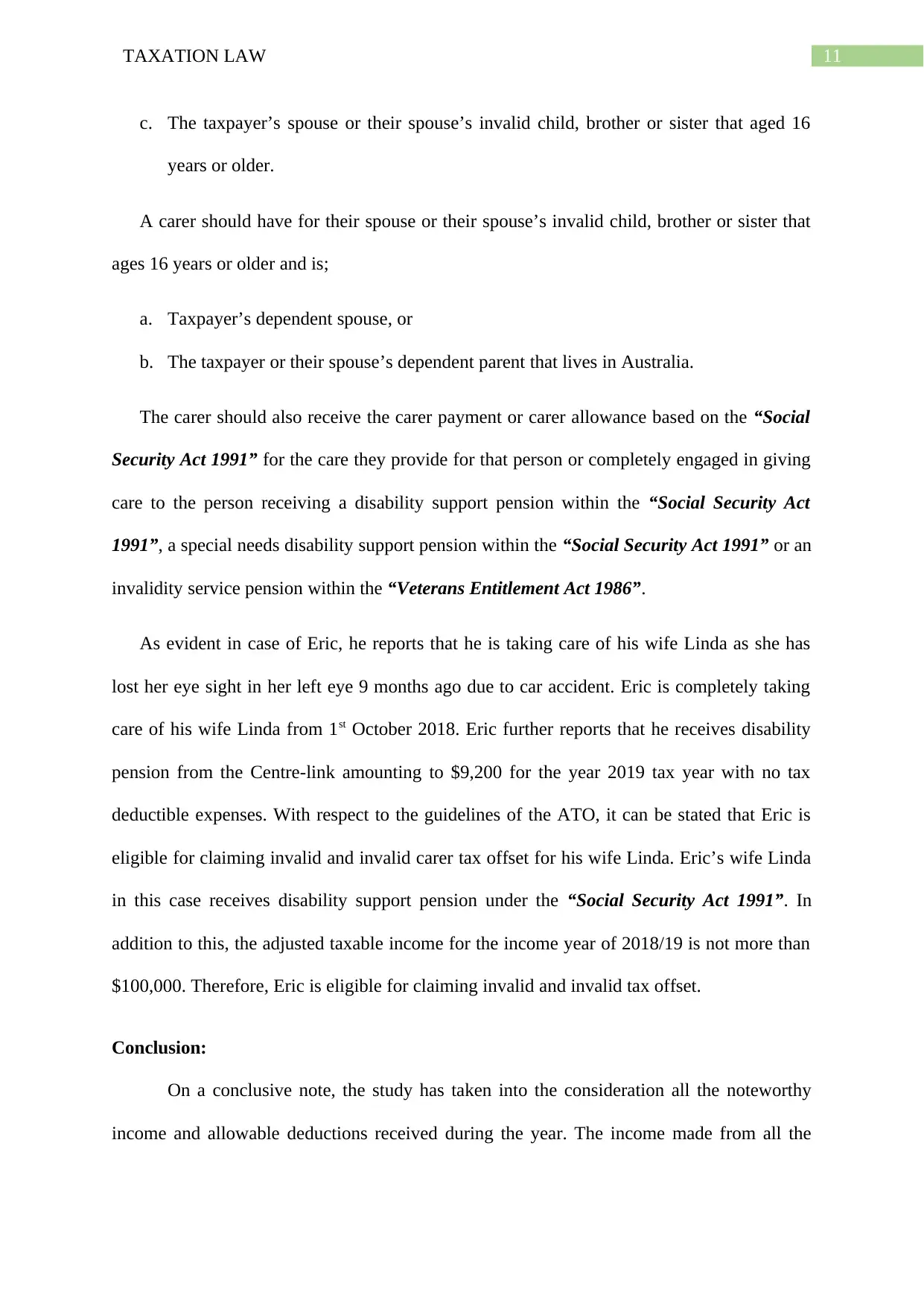
11TAXATION LAW
c. The taxpayer’s spouse or their spouse’s invalid child, brother or sister that aged 16
years or older.
A carer should have for their spouse or their spouse’s invalid child, brother or sister that
ages 16 years or older and is;
a. Taxpayer’s dependent spouse, or
b. The taxpayer or their spouse’s dependent parent that lives in Australia.
The carer should also receive the carer payment or carer allowance based on the “Social
Security Act 1991” for the care they provide for that person or completely engaged in giving
care to the person receiving a disability support pension within the “Social Security Act
1991”, a special needs disability support pension within the “Social Security Act 1991” or an
invalidity service pension within the “Veterans Entitlement Act 1986”.
As evident in case of Eric, he reports that he is taking care of his wife Linda as she has
lost her eye sight in her left eye 9 months ago due to car accident. Eric is completely taking
care of his wife Linda from 1st October 2018. Eric further reports that he receives disability
pension from the Centre-link amounting to $9,200 for the year 2019 tax year with no tax
deductible expenses. With respect to the guidelines of the ATO, it can be stated that Eric is
eligible for claiming invalid and invalid carer tax offset for his wife Linda. Eric’s wife Linda
in this case receives disability support pension under the “Social Security Act 1991”. In
addition to this, the adjusted taxable income for the income year of 2018/19 is not more than
$100,000. Therefore, Eric is eligible for claiming invalid and invalid tax offset.
Conclusion:
On a conclusive note, the study has taken into the consideration all the noteworthy
income and allowable deductions received during the year. The income made from all the
c. The taxpayer’s spouse or their spouse’s invalid child, brother or sister that aged 16
years or older.
A carer should have for their spouse or their spouse’s invalid child, brother or sister that
ages 16 years or older and is;
a. Taxpayer’s dependent spouse, or
b. The taxpayer or their spouse’s dependent parent that lives in Australia.
The carer should also receive the carer payment or carer allowance based on the “Social
Security Act 1991” for the care they provide for that person or completely engaged in giving
care to the person receiving a disability support pension within the “Social Security Act
1991”, a special needs disability support pension within the “Social Security Act 1991” or an
invalidity service pension within the “Veterans Entitlement Act 1986”.
As evident in case of Eric, he reports that he is taking care of his wife Linda as she has
lost her eye sight in her left eye 9 months ago due to car accident. Eric is completely taking
care of his wife Linda from 1st October 2018. Eric further reports that he receives disability
pension from the Centre-link amounting to $9,200 for the year 2019 tax year with no tax
deductible expenses. With respect to the guidelines of the ATO, it can be stated that Eric is
eligible for claiming invalid and invalid carer tax offset for his wife Linda. Eric’s wife Linda
in this case receives disability support pension under the “Social Security Act 1991”. In
addition to this, the adjusted taxable income for the income year of 2018/19 is not more than
$100,000. Therefore, Eric is eligible for claiming invalid and invalid tax offset.
Conclusion:
On a conclusive note, the study has taken into the consideration all the noteworthy
income and allowable deductions received during the year. The income made from all the
⊘ This is a preview!⊘
Do you want full access?
Subscribe today to unlock all pages.

Trusted by 1+ million students worldwide
1 out of 14
Related Documents
Your All-in-One AI-Powered Toolkit for Academic Success.
+13062052269
info@desklib.com
Available 24*7 on WhatsApp / Email
![[object Object]](/_next/static/media/star-bottom.7253800d.svg)
Unlock your academic potential
Copyright © 2020–2025 A2Z Services. All Rights Reserved. Developed and managed by ZUCOL.





